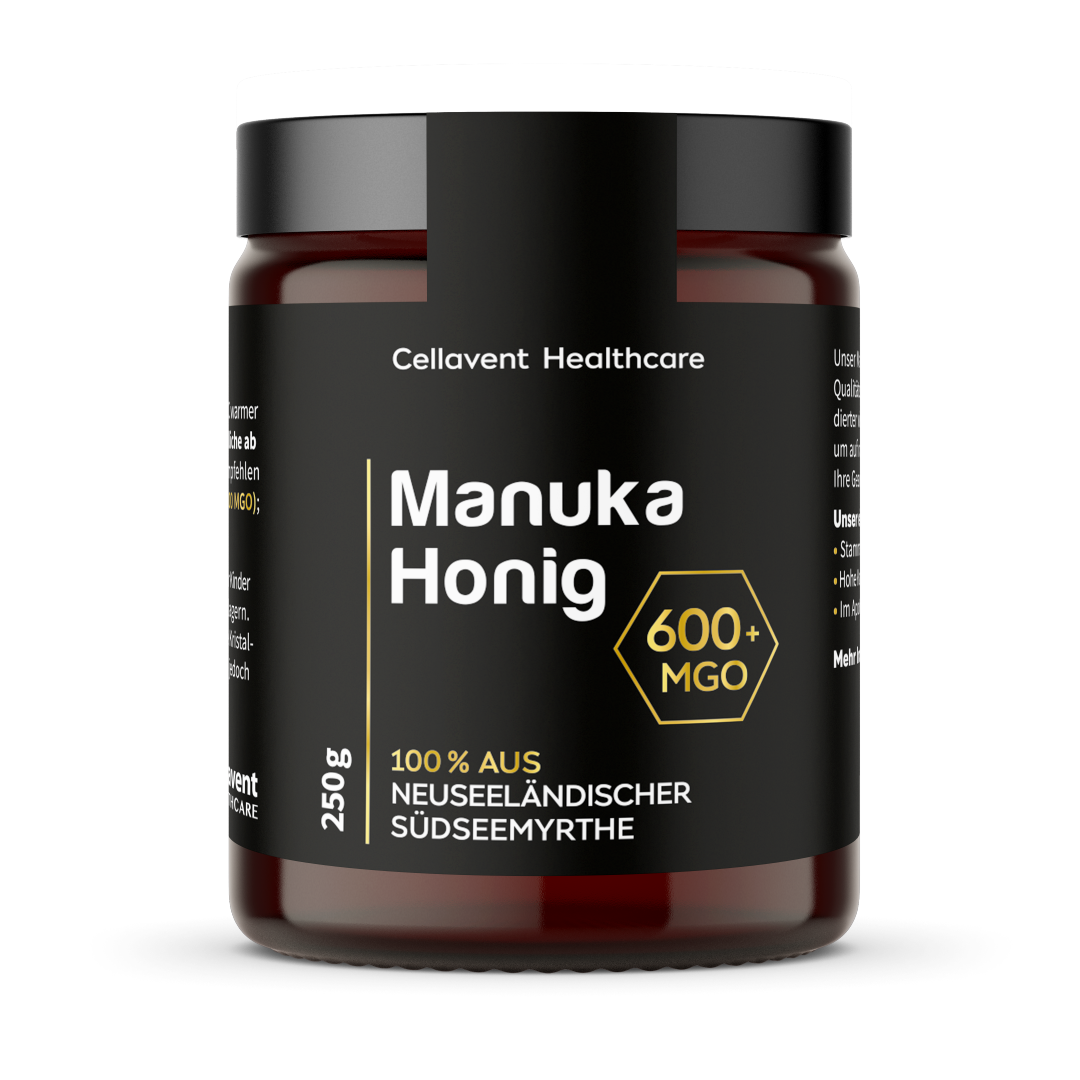
Outstanding raw material quality of our Manuka Honey 600+
- 100% certified, pure, New Zealand Manuka honey from the nectar of South Sea Myrtle flowers - also called Manuka plant
- Natural MGO value of 600+ mg/kg , which is regularly checked and certified by an accredited laboratory
- Particularly delicious and mild-creamy taste
- Bottled in high-quality pharmacy brown glass in Germany
What makes Manuka honey so special?
FOR YOUR HEALTH – Our Cellavent Manuka honey is characterized by its particularly high MGO content of over 600. Suitable for therapeutic or preventive use as well as internal and external use.
HIGHEST QUALITY – The smell and taste of our Manuka honey are unique and cannot be compared to conventional honeys. The naturally contained polyphenols and flavonoids make our honey something very special.
VERSATILE - Due to its numerous positive properties, Manuka honey can be used to prepare home remedies as well as to sweeten food and drinks. The exceptionally high MGO content also makes our Manuka honey the ideal therapy companion.
GUARANTEED ORIGIN – Our Manuka Honey 600+ is made from 100% natural nectar from New Zealand’s South Sea Myrtle flowers.
GENTLE PRODUCTION – Manuka Honey 600+ is produced under the highest quality standards and based on sound scientific expertise to naturally support your health.


Original Manuka honey from New Zealand
The special Manuka honey 600+ comes from the nectar of the rare flowers of New Zealand's South Sea myrtles , which were once used as a medicinal plant by the local Maori. With a concentration of the natural, particularly valuable ingredient methylglyoxal (MGO) of over 600+, Cellavent Healthcare Manuka honey is ideal for therapeutic use , e.g. in tried and tested home remedies, as well as for internal and external use .
The safety and origin are of course checked regularly.
What does MGO mean in Manuka honey?
The special properties of Manuka honey are largely determined by the methylglyoxal (MGO) content and its purity . The amount of MGO contained is given in milligrams per kilogram and serves as a quality measure for the honey. Methylglyoxal can also be found in small amounts in other types of honey, but the higher the proportion in the honey, the higher the quality.
For comparison, a regular flower honey has an MGO value of 0 to a maximum of 20, while Manuka honeys can reach an MGO value of up to 1000+.

Where premium quality ends, our standards only begin.
Expertise
Over 20 years of experience in the healthcare market
care
Processed and stored under strict quality controls
effectiveness
Optimal galenics to maintain effectiveness
Premium+
Development of raw materials of the highest quality

Recommended intake
Take the Manuka honey pure or diluted (in milk or tea at max. 40°C). Adults: 1-3 teaspoons per day. Teenagers aged 16 and over: 1 teaspoon of Manuka per day.
For children between 1-16 years we recommend our child-healthy Manuka honey: 1-10 years (200 MGO) ; 10-16 years (400 MGO).
Das steckt drin
100% Manuka honey from New Zealand
FAQ - The most frequently asked questions
Manuka honey comes from New Zealand and is obtained from the nectar of the Manuka plant (South Sea myrtle, lat. Leptospermum scoparium). This honey is known for its exceptional health-promoting properties.
Manuka honey contains a high proportion of methylglyoxal (MGO), which sets it apart from other types of honey. In addition, its quality is measured by the Unique Manuka Factor (UMF), which also evaluates the MGO content. Depending on the honey, this can be between 200 and 1,000 MGO.
Manuka honey can be taken pure or dissolved in warm drinks (below 40°C). For external use, simply apply to the affected area of skin.
Real Manuka honey can be identified by the MGO and UMF values on the packaging. The higher the MGO value, the better. In addition, real Manuka honey always comes from New Zealand and is obtained from the South Sea myrtle.
Manuka honey has a long shelf life and should be stored in a cool, dark place. It does not need to be kept in the refrigerator, but should be kept tightly closed.
Crystallization is a natural process that can occur in any honey. To make the honey liquid again, it can be gently warmed in a water bath without exceeding 40°C.
Children under 1 year old should not consume Manuka honey as it is a natural, raw food. Diabetics should also be particularly careful as honey naturally contains a lot of sugar and people with allergies as honey can contain pollen. If in doubt, you should always speak to your doctor before taking it.


















